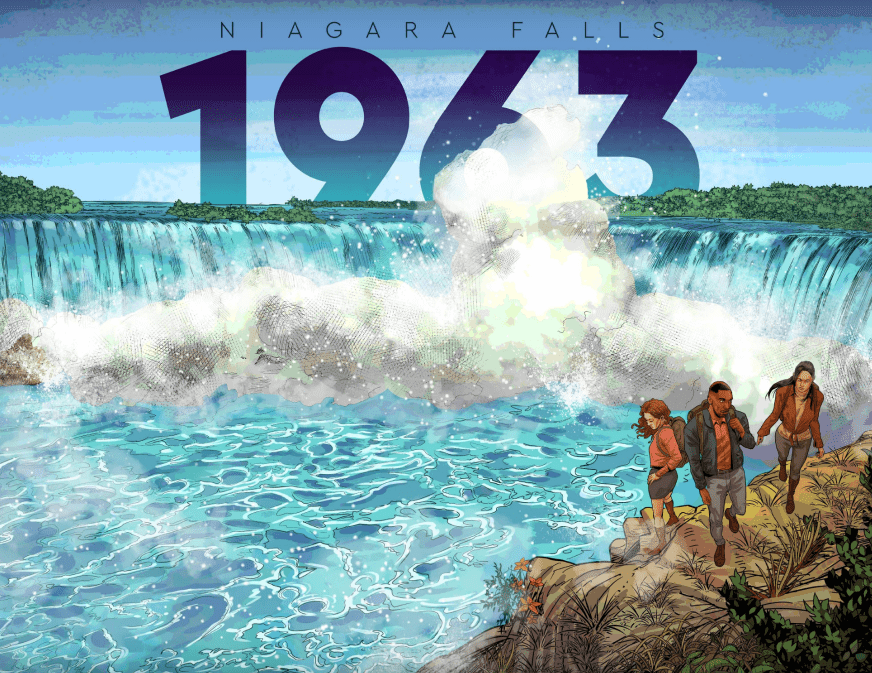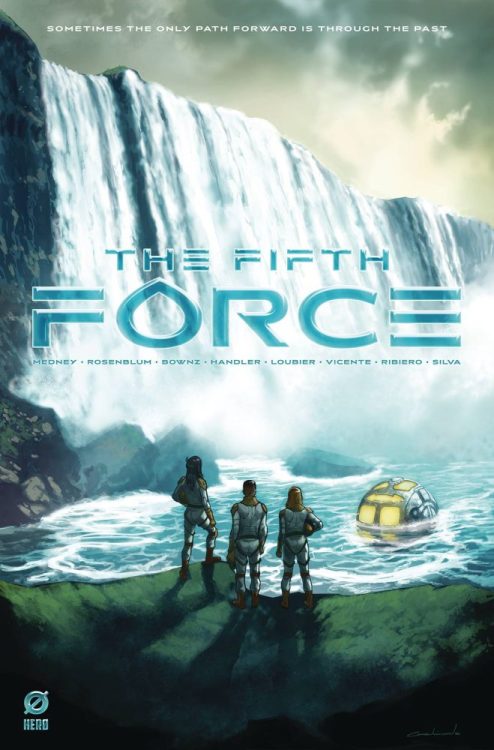Based on real world science and current conversations around the switch to renewable energy, The Fifth Force is an original Graphic Novel from the Hero Projects, and published by Heavy Metal Entertainment, that mixes fact and fiction. Focusing on decisions made in the past and the potential to change these, the comic focuses on the “what if..?” inherent in all time travel stories. Created by Catherine Loubier as a way to raise awareness in younger generations about the transition to clean energy and the potential impact on our lives, the writers and artists have turned the real world problems into a time bending, political science fiction story.
Earth is on the brink of destruction due to poor decisions made in the past. The world is choking on history’s mistakes and only the TFA, a special Canada-based agency, have a chance of saving it. They have made a revolutionary discovery which has led to the construction of a time machine. Time is running out and the TFA team only have a few jumps to put history back on the right course. Will the future scientists manage to convince the past that Humanity has to change its way?

Time Jumps and temporal slips
The premise of The Fifth Force is straight forward: it is a simple time travel story with an ecological bent. It’s the 1990s television series Sliders but with eco-warriors. Following three central characters as they travel into the past in order to save the future isn’t really new territory, but the standout factor for The Fifth Force is the motivation behind the travelers, and indeed the book itself: Climate Change. Within most mainstream comic books, any commentary about world politics is background noise to the main drama unfolding in the narrative, whereas Loubier’s creation is the reverse. Throughout the book, the driving force of the narrative is the science and the geo-political discourse across decades of the 20th and 21st centuries.
The script, written by Mathew Medney and Morgan Rosenblum, is exposition heavy as the details of the story are merged with informative details of political and cultural landscapes. The crux of the narrative is that the TFA are attempting to change the world’s reliance on fossil fuels, and the script uses this to educate the reader in all of the elements of the discussion around Clean Energy. The pros and cons are discussed as part of the larger story with potential risks playing out through the narrative, highlighting dangers, but also demonstrating the potential rewards for the planet and Humanity.
This type of narrative can become very preachy, spending more time on the message and not enough on the story. Medney and Rosenblum are able, for the most part, to integrate both aspects into a science fiction adventure story with a surprising pace, packed with twists and turns that will keep the reader turning the pages. It is true that many of the twists and turns won’t be shocking to aficionado’s of time travel adventures but a newer, younger audience will be swept up by these changes in narrative direction. Even though the inclusion of climate change as a narrative driving force has been used before — such as in the movie Millennium from 1989 which used pollution as the reason for the time travelers jaunts into the past, and in the novel Superseeds by Geoffrey Beevers — in this instance, the message is also the story. In Superseeds, Beevers uses a time travel element to enable the leading scientist to stop world famine, but the heart of the story is a beautiful yet tragic love story, whereas The Fifth Force wants Climate Change to be the leading element and the characters to play second fiddle. The three central agents have moments of character, but these are often lost or forgotten as the story traverses forward. For brief moments, you get to see behind Martina Silas’ brash exterior, and then you wait for this element of the character to be explored, but it never comes to fruition. Perhaps a follow-up series could expand on the characters and the world they inhabit, acting as a companion piece to this original graphic novel.

Art and design
One of the greatest challenges for new comics is getting the world design to fit the narrative. Visual tone and atmosphere is everything in order for a book like this to work. The main focus of The Fifth Force is to engage younger generations, some who may not be avid, or even casual, comic readers. With this aim, Adriano Vicente does an excellent job of creating visuals that are both futuristic but also recognizable. At no point does the future world become something that isn’t accessible. This isn’t about breaking boundaries design-wise; the aim is to engage through recognition and to facilitate understanding and learning. Vicente has designed the characters and locations to do just this. It’s not fancy, out-of-this-world vistas as you might expect from Moebius’ work or other contributors to Heavy Metal magazine. This is mainstream television level visuals, not an art house French movie.
The characters are individual, easily recognizable from panel to panel, and emote well on the page. Vicente has a good flair for dramatic poses and shifts the viewing angles across the page to draw the reader into the story and punctuates various narrative points. Occasionally, the panel layouts are confusing and difficult to read. The expected reading order of the panels on some pages have been altered, which could cause new comic readers to lose their place and potentially push them out of the story. There are several pages that would have Neil Cohn scratching at his head, but as a general rule, the construction of this book is straight forward and easy to read.
The color work is exciting and bright, again leaning into the audience it is aimed at. Despite the End of the World narrative, the coloring is almost fun, allowing characters and locations to pop from the page. There is an overpowering sense of the dramatic built into The Fifth Force, something that colorist Thiago Ribiro, and later on William Soares and Flavio Silva, picks up on. “Keep it clean and keep it entertaining” appears to have been their brief, one that they adhere to on every page.
Similarly, the lettering, also by Flavio Silva with Mohamed Samah, ticks all the right boxes. There is nothing experimental or groundbreaking, but that’s not what is required in this book. There is a mission behind The Fifth Force and the artists are there to help promote that, not bedazzle the reader with expressive art. Although, for those readers who are looking, there are a number of wonderful nods to other great works of science fiction and time travel. Images that reference Planet of the Apes, designs reminiscent of Squid Game, and sequences straight out of a H. G. Wells novel.

Conclusion
The Fifth Force has an agenda, conceived by Catherine Loubier and propagated by the artists. It is a worthy cause and the intentions behind producing this graphic novel, to reach younger generations, have shaped the way this book has been produced and laid out. It should have a place on the shelves of any school library and in the classrooms and lecture halls of all educational establishments. From a purely comics point of view, it toes the line of standard comic book conventions without challenging any of these concepts. The narrative has been delicately constructed but nothing within the story is particularly new or exciting.
Although there are other comics available with a similar concept, The Fifth Force has an emphasis on its message and is aimed, primarily, at a different audience to most mainstream comics. This isn’t the X-Men fighting for survival in Days Of Futures Past or the DC superheroes trying to unravel the goings on in Zero Hour; The Fifth Force is rooted in real world science with a real world goal. If some of the plot had been tighter and the layouts were more challenging, this book may have a greater appeal, however, for the intended audience and purpose, The Fifth Force is a clever, educational read and will be the perfect book to study in either science or art classes.


